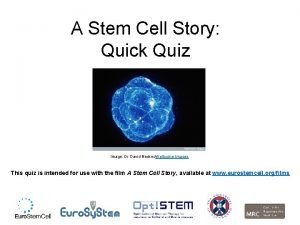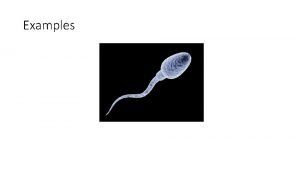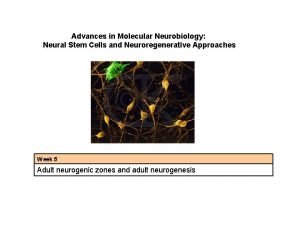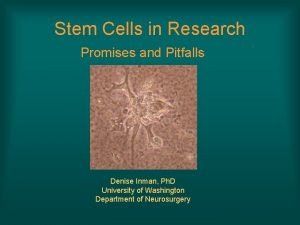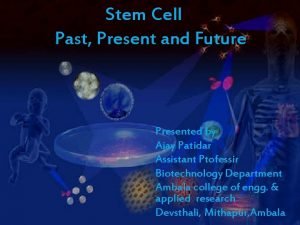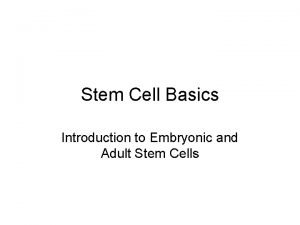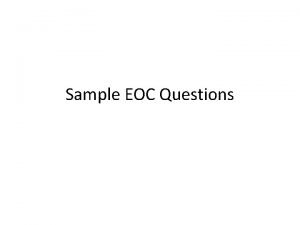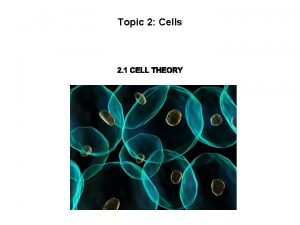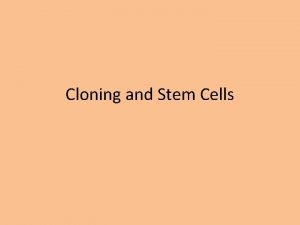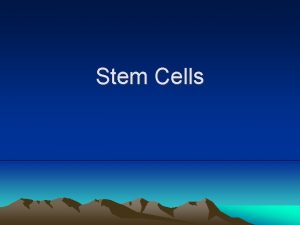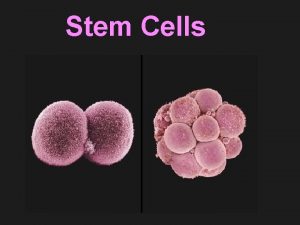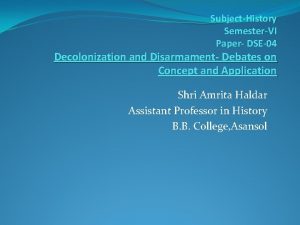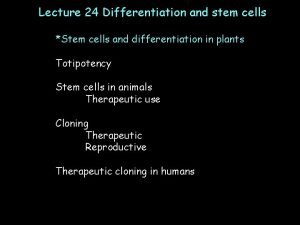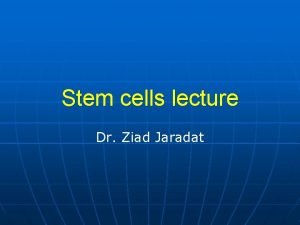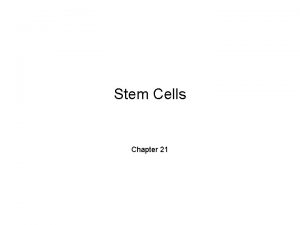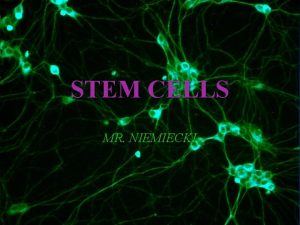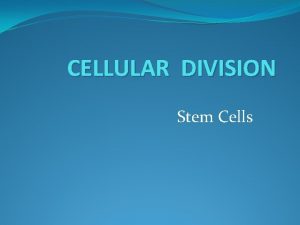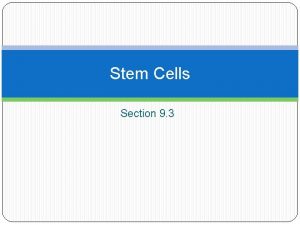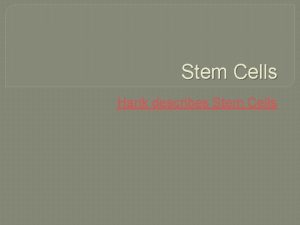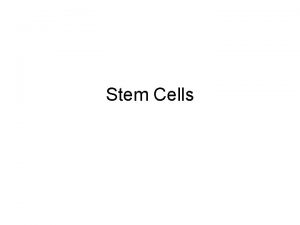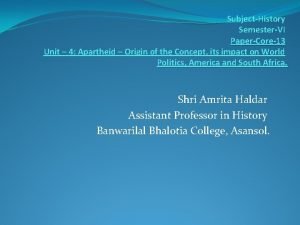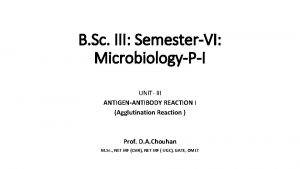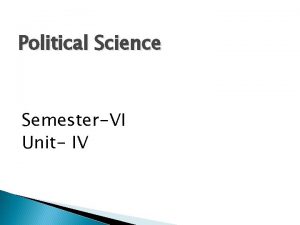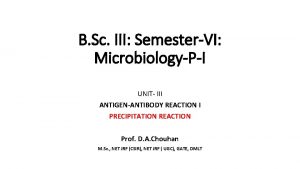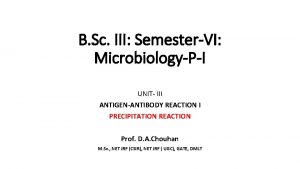STEM CELLS SemesterVI Paper C 13 T Unit



![Unique properties of all stem cells 1] Stem cells are unspecialized One of the Unique properties of all stem cells 1] Stem cells are unspecialized One of the](https://slidetodoc.com/presentation_image_h2/f7e6bfcd98c35b618916d50a30bd653f/image-4.jpg)
![Contd. 3] Differentiation They can give rise to specialized tissue. Under certain physiological and Contd. 3] Differentiation They can give rise to specialized tissue. Under certain physiological and](https://slidetodoc.com/presentation_image_h2/f7e6bfcd98c35b618916d50a30bd653f/image-5.jpg)





















- Slides: 26

STEM CELLS Semester-VI Paper- C 13 T Unit- 5 Atanu Das

INTRODUCTION Stem cells are one of the most fascinating areas of biology today. Stem cells are a special kind of cell that has the ability to divide indefinitely and have the potential to give rise to specialized cells (that is, any cell of the body).

![Unique properties of all stem cells 1 Stem cells are unspecialized One of the Unique properties of all stem cells 1] Stem cells are unspecialized One of the](https://slidetodoc.com/presentation_image_h2/f7e6bfcd98c35b618916d50a30bd653f/image-4.jpg)
Unique properties of all stem cells 1] Stem cells are unspecialized One of the fundamental properties of stem cells is that it does not have any tissue specific structures that allow it to perform specialized function. 2] Proliferation They are capable of dividing and renewing themselves for indefinite periods
![Contd 3 Differentiation They can give rise to specialized tissue Under certain physiological and Contd. 3] Differentiation They can give rise to specialized tissue. Under certain physiological and](https://slidetodoc.com/presentation_image_h2/f7e6bfcd98c35b618916d50a30bd653f/image-5.jpg)
Contd. 3] Differentiation They can give rise to specialized tissue. Under certain physiological and experimental conditions unspecialized cell can give rise to specialized cells such as including heart muscle cells, blood cells or nerve cells required to repair damaged or depleted adult cell population or tissue. 4] Plasticity Stem cell from one tissue may be able to give rise to cell types of completely different tissue, a phenomenon known as plasticity. e. g. Blood cells becoming neuron, liver cells producing insulin and haematopoietic stem cells, developing into heart muscle.

Stem cell timeline Single Cell Embryo ↓ Totipotent 5 -7 Day Embryo ↓ Embryonic Stem (ES) Cells Pluripotent Infant Adult “Adult” Stem Cells Multipotent Cord Blood Stem Cells Placental Stem Cells Multipotent



► Pluripotent stem cells. These are true stem cells, with the potential to make any differentiated cell in the body (but probably not those of the placenta which is derived from the trophoblast).


Two types of pluripotent stem cells have been found - Embryonic Stem (ES) Cells. These can be isolated from the inner cell mass (ICM) of the blastocyst — the stage of embryonic development when implantation occurs. For humans, excess embryos produced during IVF procedures are used. - Embryonic Germ (EG) Cells. are derived from the part of a human embryo or foetus that will ultimately produce eggs or sperm (gametes).

Properties of Embryonic Stem Cell (ESC) ØPluripotent : Embryonic stem cells of the inner cell mass are pluripotent, meaning they are able to differentiate to generate primitive ectoderm, which ultimately differentiates during gastrulation into all derivatives of the three primary germ layers: ectoderm, endoderm, and mesoderm. ØSelf-renewing : Under defined conditions, embryonic stem cells are capable of self-renewing indefinitely in an undifferentiated state. ØGrowth: ESCs divide very frequently due to a shortened G 1 phase in their cell cycle. Rapid cell division allows the cells to quickly grow in number, but not size, which is important for early embryo development.


How are embryonic stem cells harvested? Growing cells in the laboratory is called as cell culture. Human ES cells are derived from 4 -5 day old blastocyst Blastocyst structures include: - Trophoblast: outer layer of cells that surrounds the blastocyst & forms the placenta - Blastocoel: the hollow cavity inside the blastocyst that will form body cavity - Inner cell mass: a group of approx. 30 cells at one end of the blastocoel: • Forms 3 germ layers that form all embryonic tissues (endoderm, mesoderm, ectoderm)



Cell Culture Techniques for ESC Isolate & transfer of inner cell mass into plastic culture dish that contains culture medium Cells divide and spread over the dish Inner surface of culture dish is typically coated with mouse embryonic skin cells that have been treated so they will not divide

This coating is called a FEEDER LAYER - Feeder cells provide ES cells with a sticky surface for attachment - Feeder cells release nutrients Recent discovery: methods for growing embryonic stem cells without mouse feeder cells - Significance - eliminate infection by viruses or other mouse molecules ES cells are removed gently and plated into several different culture plates before crowding occurs

► Over the course of several days the inner cell mass proliferate and begin to crowd the culture dish. ► They are then gently removed and plated into several fresh culture dishes. - The process of plating the cells is repeated several times and for many months and is called subculturing. - Each cycle of subculturing is referred to as a passage. ► After six months or more the inner cell mass yield millions of embryonic stem cells. These cells are pluripotent and appear genetically normal and are referred to as an embryonic stem cell line.


Embryonic vs Adult Stem Cells • Totipotent • - Differentiation into ANY cell type • - Differentiation into some cell types, limited outcomes Known Source • Large numbers can be harvested from embryos • May cause immune rejection - Rejection of ES cells by recipient has not been shown yet Multi or pluripotent • • Unknown source Limited numbers, more difficult to isolate • Less likely to cause immune rejection, since the patient’s own cells can be used

Potential Uses of Embryonic Stem Cells Cell replacement therapies: Current research focuses on differentiating ESCs into a variety of cell types for eventual use as cell replacement therapies (CRTs). Some of the cell types that have or are currently being developed include cardiomyocytes (CM), neurons, hepatocytes, bon e marrow cells, islet cells and endothelial cells.

Potential uses Biotechnology (drug discovery & development) - stem cells can provide specific cell types to test new drugs - Safety testing of new drugs on differentiated cell lines. Screening of potential drugs • Cancer cell lines are already being used to screen potential anti-tumor drugs • Availability of pluripotent stem cells would allow drug testing in a wider range of cell types & to reduce animal testing

Potential uses Cell based therapies: - Regenerative therapy to treat Parkinson’s, Alzheimer’s, ALS, spinal cord injury, stroke, severe burns, heart disease, diabetes, osteoarthritis, and rheumatoid arthritis

Potential uses Stem cells in gene therapy • Stem cells as vehicles after they have been genetically manipulated

Key Ethical Issues The blastocyst used in stem cell research is microscopically small and has no nervous system. Does it count as a “person” who has a right to life? What do various religions say about when personhood begins? Does science have a view on this? In a society where citizens hold diverse religious views, how can we democratically make humane public policy?
 Where can scientists obtain stem cells? *
Where can scientists obtain stem cells? * Pluripotent stem cells examples
Pluripotent stem cells examples Stem cells
Stem cells Conclusion of stem cells
Conclusion of stem cells Images with creative commons license
Images with creative commons license Precursor cells
Precursor cells Classification of stem cells
Classification of stem cells Biochemistry questions
Biochemistry questions Outline the cell theory
Outline the cell theory Stem cells webquest
Stem cells webquest Stem cells specialization
Stem cells specialization Onodi cells
Onodi cells Proximal convoluted tubule
Proximal convoluted tubule Thyroid gland
Thyroid gland Haploid vs diploid venn diagram
Haploid vs diploid venn diagram Somatic cells vs germ cells
Somatic cells vs germ cells Chlorocruorin
Chlorocruorin Prokaryotic and eukaryotic cells worksheet
Prokaryotic and eukaryotic cells worksheet Plant cell and animal cell venn diagram
Plant cell and animal cell venn diagram Prokaryotic cells vs eukaryotic cells
Prokaryotic cells vs eukaryotic cells Organelle trail
Organelle trail Masses of cells form and steal nutrients from healthy cells
Masses of cells form and steal nutrients from healthy cells Label
Label What animals have prokaryotic cells
What animals have prokaryotic cells Which organisms are prokaryotes
Which organisms are prokaryotes Chapter 8 cellular reproduction cells from cells
Chapter 8 cellular reproduction cells from cells Cell substance
Cell substance
